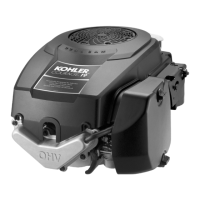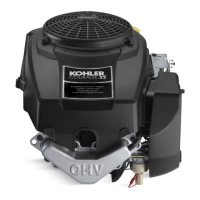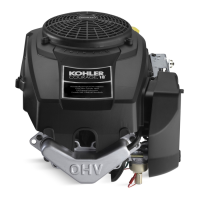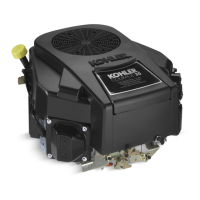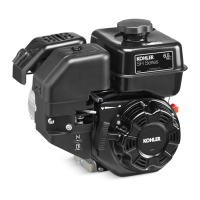7.6
Section 7
Electrical System and Components
NOTE: Do not allow the baking soda solution to
enter the cells of the battery, as this will
destroy the electrolyte.
Battery Test
Test the battery voltage by connecting a DC voltmeter
across the battery terminals and cranking the engine.
If the battery drops below 9 volts while cranking, the
battery is discharged or faulty. Refer to Figure 7-6.
DC
Voltmeter
Battery
Battery
A 12 volt battery with a minimum current rating of 250
cold cranking amps is recommended. The actual cold
cranking amp requirement depends on engine size,
application and starting temperatures. As temperatures
decrease, cranking requirements increase but battery
capacity shrinks. Refer to the operating instructions of
the equipment this engine powers for specific battery
requirements.
If the battery charge is not sufficient to crank the
engine, recharge the battery. Do not jump start using
another battery.
Battery Charging
WARNING: Explosive Gases!
Batteries produce explosive hydrogen gas while being
charged. To prevent a fire or explosion, charge
batteries only in well ventilated areas. Keep sparks,
open flames, and other sources of ignition away from
the battery at all times. Keep batteries out of the reach
of children. Remove all jewelry when servicing
batteries.
Before disconnecting the negative (-) ground cable,
make sure all switches are OFF. If ON, a spark will
occur at the ground cable terminal, which could cause
an explosion if hydrogen gas or gasoline vapors are
present.
Battery Maintenance
Regular maintenance will ensure the battery will
accept and hold a charge.
1. Regularly check the level of electrolyte. Add
distilled water as necessary to maintain the
recommended level.
NOTE: Do not overfill the battery. Poor
performance or early failure due to loss
of electrolyte will result.
2. Keep the cables, terminals, and external surfaces
of the battery clean. A build-up of corrosive acid or
grime on the external surfaces can self-discharge
the battery. Self-discharging happens rapidly
when moisture is present.
3. Wash the cables, terminals, and external surfaces
with a baking soda and water solution. Rinse
thoroughly with clear water.
Figure 7-6. Checking Battery Voltage.
Electrical Systems Wiring Diagrams and
Battery Charging Systems
Most engines are equipped with either a 9 or 15 amp,
regulated battery charging system. Some have a 3
amp, unregulated system with a 70 watt lighting circuit.
Refer to the following wiring diagrams and
troubleshooting guides to test and service the system.
NOTE: Observe the following guidelines to prevent
damage to the electrical system and
components.
1. Make sure the battery polarity is correct. A
negative (-) ground system is used.
2. Disconnect the battery cables (negative (-) cable
first), before doing electric welding on the
equipment powered by the engine.
3. Prevent the stator leads from touching or shorting
while the engine is running. This could damage
the stator.
Not For Resale
www.SmallEngineDiscount.com

